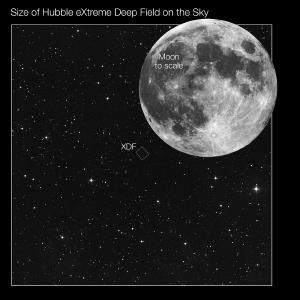Blog
Scale
18 February 2014
One of my favorite objects in the night sky is the Orion nebula. It’s easy to find, just below the belt stars in the constellation Orion, and it is the closest stellar nursery. It’s also a bit bigger than the Moon. Actually that’s a bit misleading. It is actually about 24 light years across, but because it is also about 1300 light years away, its apparent diameter is about a degree, which is about twice the apparent diameter of the Moon.
 The Wondrous Sky
The Wondrous SkyIn astronomy, apparent size is important because it’s one of the factors that determines our ability to observe them in detail. With any telescope, there is a limit to how close two features can be before they blur together. This is known as its resolving power. For a simple telescope, this is a function of the diameter of its main mirror or lens (all other things being equal). A 4″ telescope, for example, has a resolving power of about 2 arcseconds. An arcsecond is 1/3600 of a degree, so using such a telescope to look at the Moon would be kind of like looking at an image of the Moon about 900 pixels wide.
Of course there are other factors as well. The resolution power of telescopes also depends on the wavelength at which you are observing, then there is the issue of how much light pollution you have in your area, whether the air above you is calm or turbulent, and others. Usually a backyard telescope can’t resolve things to their theoretical limit.
 NASA/Hubble
NASA/HubbleOne way to overcome many issues is to put your telescope in space. The Hubble space telescope is above the atmosphere, so it can resolve things at close to its resolution power, which is about 100 milliarcseconds. This is one of the reasons we put telescopes in space.
One way to overcome the resolution limit is to use multiple telescopes. This process is known as interferometry. The light gathered from multiple telescopes can be combined to create a “virtual” telescope. The greater the virtual size, the more resolution you can have. This particularly useful with radio telescopes. The largest of these is the Very Long Baseline Array, which has an effective diameter of over 8,000 kilometers.
When things are billions of light years away, even large objects have a tiny apparent diameter. This is why we’re always striving for greater resolution in our telescopes.
It’s all a matter of scale.